| This article covers something that is not from the Mario franchise. | |
|---|---|

|
Make sure to only provide information (including a profile) relevant to the Mario franchise and related media. |
| "Can everyone please stop telling jokes and start actually helping?!" | |
|---|---|

|
Wendy O. Koopa is not happy. She has spotted broken links on this article. You can help her by creating some of the articles! |
Link is the main character and mascot of the The Legend of Zelda franchise, and one of Nintendo's stars. Hailing from the Kingdom of Hyrule, in most main games of his long-running series, he is tasked with stopping rescuing Princess Zelda from the clutches of Ganon, sometimes the fiend's human form Ganondorf. Link has made several appearances in Mario-related media, especially because much like the franchise itself, The Legend of Zelda is also a creation of Shigeru Miyamoto and Takashi Tezuka, and their older games were made by the very same development team. The first time Link appears in any Mario game is Super Mario Bros. & Friends: When I Grow Up in 1992. He is the Zelda equivalent of Mario, and Link himself is also known as one of the plumber's closest friends outside of the Mushroom Kingdom.
Profile
Physical description

Like most other classic Nintendo characters, Link's physical characteristics fluctuate from game to game, though he usually has light-colored hair (ranging from brown to blonde to orange), blue eyes, and a medium build. Other characters, most often females, sometimes think of him as handsome. Although Link is normally shown as a child, some games depict him as a teen or young adult, and apparently never exceed nineteen or twenty years at any point in the long-running series thus far. Ocarina of Time in particular remains the only game where the hero is seen in two different maturity stages. In A Link to the Past, he was depicted as having pink hair in-game, due to graphics limitations of the Super NES, although the artwork for the game depicts him as having auburn hair. Similarly, Link's Awakening DX and the Oracle games on the Game Boy Color depicted Link's overworld sprite as having black hair, presumably for the same reason as Link's pink hair in A Link to the Past, although the in-game cutscenes and to a certain extent photos depicted him with auburn/light-colored hair, alongside his character artwork.
In some installments of the series, Link is the bearer of the Triforce of Courage. Several games mention a Triforce mark on Link's left hand, which identifies him either as a chosen hero or the holder of the Triforce of Courage. Older incarnations of Link have rather well-built physiques while younger versions of him are at least moderate in size. Surprisingly in Twilight Princess, Link appears to be slightly short for his age, with both Princess Zelda and Midna (in her true form) being clearly taller than him. Interestingly, Link bears a resemblance to the Disney version of Peter Pan, as they are both elf-like, wear green clothing, fight with swords, and are sometimes accompanied by a Fairy. Link also fights his own shadow in some games, either Dark Link or Shadow Link, just like Peter. Shigeru Miyamoto once mentioned that he used Peter Pan as a bit of an inspiration for Link's design in The Legend of Zelda, as he loved the 1953 Disney film.
According to Yoshiaki Koizumi, there were initially plans to give Link a button nose similar to that of Mario, but his wife rejected it, citing that Nintendo already gave too many funny noses to their characters and suggested a more handsome nose for a change.[1]
Personality traits
A peculiarity of Link, as well as other main characters (specifically Princess Zelda and Ganon), is the several different incarnations of the person throughout The Legend of Zelda series. He is implied to be somewhat sleepy or lazy at first since at some point near the beginning of every game except the first two, Majora's Mask, Oracle of Seasons/Ages, Four Swords, Four Swords Adventures, Twilight Princess, and Tri Force Heroes, he is sleeping or dozing off.
Since Link is not normally shown to speak, similar to Mario, his personality is mainly determined by his actions or others' comments about him. Currently, only one incarnation of Link was ever shown to directly speak and it was the Hero's Shade; the regretful but legendary Hero of Time - himself none other than the iconic incarnation from Ocarina of Time and Majora's Mask. Link has never visually spoken in any of the main Zelda games, other than noises (such as grunts or "Meow" in The Wind Waker), although optional texts the player can choose when talking to certain characters implies he is not necessarily mute. Link does fully speak in other media within the franchise, however, such as the 1989 TV show, mangas, etc.
It is shown that Link possesses basic characteristics found in any heroic character; bravery, compassion, determination, and wisdom. He would even go to save others that were his enemies (albeit rarely). These characteristics allow him to wield the complete Triforce or the Master Sword without a problem.
Being dexterous, Link can quickly understand the complex mechanics behind things or figure out an opponent's weakness to use against them. This has proven invaluable in many situations, with both foes and allies alike showing surprise at his ingenuity.
Link deeply values his ties with loved ones. His care towards allies has been noted several times, and is considered by some to be one of his greatest strengths.
Link himself is widely known to be a fierce fighter and is among the strongest playable protagonists by Nintendo, if not the video game industry as a whole, among the likes of Mario or Kirby.
In Super Mario Bros. & Friends: When I Grow Up
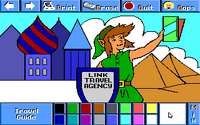
Link makes a cameo appearance on two pages. He is first shown on the "Chef" page, waiting to be served a pasta dish cooked by Mario. He is also shown on the "Travel Guide" page, standing in front of what appears to be the Taj Mahal on one side and Egyptian pyramids on the other. Link's shield shows the text "Link's Travel Agency."
In Donkey Kong franchise
Link has made a few cameo appearances within the Donkey Kong games.

In Donkey Kong Country 2: Diddy's Kong Quest and Donkey Kong Land 2, Link, alongside Mario and Yoshi, all make a cameo as characters present in Cranky's Video Game Heroes. This would be technically Link's first 3D appearance prior to Ocarina of Time on the Nintendo 64.
In Donkey Kong Country 3: Dixie Kong's Double Trouble!, Link is mentioned by Bazaar in his store if Dixie and Kiddy do not wish to hear his explanation about the Mirror. This mention was removed from the Game Boy Advance version.
In Donkey Konga 2, Link is among the characters who makes a cameo appearance as a badge. He and a few other The Legend of Zelda characters also make a cameo as slots within the slot machine. Both the badge and slot of Link depicts his appearance from The Legend of Zelda: The Wind Waker. The same badge of Link was retained in Donkey Konga 3 JP.
In Super Mario RPG: Legend of the Seven Stars
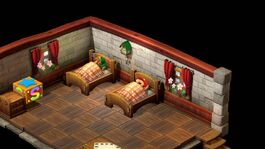
Link can be found sleeping in a bed at the Rose Town's inn. Because he himself is generally a silent protagonist like Mario, talking to Link causes a The Legend of Zelda melody for uncovering a secret to play instead. Samus Aran from the Metroid series also makes a similar cameo. Link retains this cameo in the Super Mario RPG remake for Nintendo Switch.
In Mario Golf series
Although never visibly seen in-game, Link's name is among those shown on the score chart in Mario Golf for the Nintendo 64 as well as Mario Golf for the Game Boy Color.
In Mario Artist: Paint Studio
There are a few stamps depicting Link's artwork from The Legend of Zelda: Ocarina of Time, including his young form, his adult form, and his adult form riding Epona.
In Game & Watch Gallery 4
Link stars as a playable character in the Game & Watch port of Zelda, having the same role as in the original game.
In WarioWare series
Link is featured in every The Legend of Zelda-themed microgames from 9-Volt and 18-Volt.
WarioWare, Inc.: Mega Microgame$! / WarioWare, Inc.: Mega Party Game$!
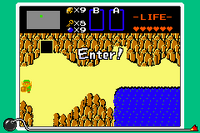
Link appears in the The Legend of Zelda microgame, set within the The Legend of Zelda game itself. The object is for the player to guide Link into a cave. In Level 2, Link has to avoid a Peahat along the way, and in Level 3, he also has to avoid an energy ball spit by a Zora. If Link does not make it to the cave on time, the player loses at the microgame.
WarioWare: Twisted!
Link appears in a different microgame also named The Legend of Zelda, also based on the game of the same name. The player has to rotate the handheld to have Link use his shield to deflect a rock spit out by each red Octorok. In Level 1, Link only has to deflect two rocks, while Level 2 requires him to deflect three rocks. Lastly, Level 3 features a group of Octoroks, only a few of which spit out a rock.
WarioWare: Twisted!
In another The Legend of Zelda microgame, if successfully completed by the player, Link can be seen holding up a Nintendo DS as a treasure triumphantly.
WarioWare: Smooth Moves
Link appears in three different microgames, two featuring him as playable and one in which he makes a cameo. Each microgame features a Link from a different The Legend of Zelda game.
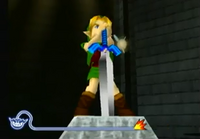
In Ocarina of Time, based on The Legend of Zelda: Ocarina of Time, Young Link must draw the Master Sword from its pedestal. In Level 1, this turns him into an adult, like in the actual game. In Level 2 this turns Link old and gives him a gray beard. In Level 3, he turns into a Cucco. The main difference between each difficulty level is that higher ones require Link to yank the Master Sword more times.
In The Wind Waker, based on The Legend of Zelda: The Wind Waker, Toon Link is gliding over the sea with the Deku Leaf, and he has to land on a tree trunk-shaped platform.
In Opening Night, Link makes a cameo as one of the instrument players within the orchestra, and he plays the violin in particular. This could be a nod to the Nintendo characters dancing and playing instruments in the type B mode of Tetris for the Nintendo Entertainment System.
WarioWare: D.I.Y.
Link is the main character in the Zelda microgame, based on The Legend of Zelda: Phantom Hourglass incarnation. Here, the player has to tap Chuchus for Link to attack and defeat them using his sword.
WarioWare: D.I.Y. Showcase
Link is playable in the Zelda 2 microgame, based on Zelda II: The Adventure of Link. Here, Link has to deflect a Goriya's boomerangs with his shield.
WarioWare Gold
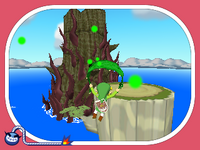
Link is playable in four microgames, three of which return from earlier WarioWare installments: The Legend of Zelda from WarioWare, Inc.: Mega Microgame$! as well as Ocarina of Time and The Wind Waker, both from WarioWare: Smooth Moves. Link's fourth microgame appearance is in the newly-introduced Phantom Hourglass, another microgame based on The Legend of Zelda: Phantom Hourglass; in it, the object is for the player to have Link hit a switch by tracing a line to it for the boomerang to follow.
WarioWare: Get It Together!
Link makes an appearance a microgame titled The Legend of Zelda: Breath of the Wild, based on the game of the same name. He is not playable, and stands to the right side as the player has to break an object frozen by the Stasis Rune. If the player successfully knocks the object away, Link happily jumps with his fist raised up.
WarioWare: Move It!
Link appears in the microgame The Legend of Zelda: Ocarina of Time 3D, where he is considerably portrayed as an antagonist because the gameplay involves a Cucco having to avoid being caught by Link.
In Captain Rainbow
Link makes a cameo appearance as a portrait above Tracy's throne, alongside Mario. The portrait of Link depicts his artwork from The Legend of Zelda: Twilight Princess.
In Super Mario series
Super Mario 3D World / Super Mario 3D World + Bowser's Fury
Rainbow Run features a secret a secret area where walking on the panels gradually reveals a depiction of an enlarged sprite of Link from The Legend of Zelda. Once every panel has been revealed, the iconic fanfare from The Legend of Zelda from when obtaining an item is played, and the second Green Power Star is revealed. An arrangement of the overworld theme from The Legend of Zelda then plays until the characters leave the area.
Super Mario Maker / Super Mario Maker 2
In both games, Mario can transform into Link by touching the Master Sword item. In Super Mario Maker, there are a few different Mystery Mushroom costumes of Link.
Attention Mario Wiki users!: This section is short or lacks sufficient information. We would appreciate it if you help the Mario Wiki by expanding it.
In Mario Kart series
Mario Kart 8

Link was introduced as a playable character within the The Legend of Zelda x Mario Kart 8 downloadable pack alongside Tanooki Mario and Cat Peach. The pack also gave Link his own course, Hyrule Circuit. This marks the first time Link is depicted being able to drive high-tech vehicles (which is met with mixed reactions among Zelda fans). The incarnation in this game is the Hero of the Sky from Skyward Sword.
Mario Kart 8 Deluxe
Link and the other content included within The Legend of Zelda x Mario Kart 8 were incorporated into the base game.
On July 19, 2018, an update to the game added the Hero of the Wild (i.e. Link's standard outfit from Breath of the Wild) as a playable character. Upon being added, the Hero of the Wild became the default Link rather than the Hero of the Sky, and the one with a green tunic was relegated to being an alternate character. Both Links are left-handed, although the Hero of the Wild is right-handed in The Legend of Zelda: Breath of the Wild.
Crossover appearances
Aside from appearing in Mario and its spinoffs, Link has appeared alongside Mario characters in several crossover series and several non-Mario games.
Tetris series
Tetris (Nintendo Entertainment System)
On the results screen after clearing Type B, various Nintendo characters are seen dancing and playing instruments. Link in particular can be seen playing a flute.
Tetris DS
Link, reusing his sprite appearance from The Legend of Zelda, makes a few cameo appearances.
Attention Mario Wiki users!: This section is short or lacks sufficient information. We would appreciate it if you help the Mario Wiki by expanding it.
F-1 Race
Link is among the Nintendo characters to be shown when completing a course. Link in particular is seen cheering on the player when they complete course 4.
Super Smash Bros. series
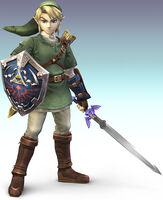
Link is a default playable character in every installment, starting with the first Super Smash Bros.. he wields the Master Sword as well as many of his traditional weapons. In Super Smash Bros. Melee, Link was joined by fellow The Legend of Zelda character Sheik, Princess Zelda, Ganondorf and Young Link. In Super Smash Bros. and Super Smash Bros. Melee, Link is designed after his appearance in The Legend of Zelda: Ocarina of Time.
Link returns alongside Zelda, Sheik and Ganondorf in Super Smash Bros. Brawl and joined by Toon Link. Link is in his Twilight Princess incarnation. He and the other Zelda cast reappeared in Super Smash Bros. for Nintendo 3DS / Wii U. However, Link's overall color scheme is noticeably more vibrant because of Super Smash Bros. for Nintendo 3DS / Wii U's aesthetics, making him look more like his Skyward Sword incarnation, whom was otherwise unused in Smash Bros., but retained his Twilight Princess design.
Link returns in Super Smash Bros. Ultimate as a playable character. Initially teased alongside Mario and Inkling during the then-unnamed Super Smash Bros. trailer at the end of the March 8th, 2018 Nintendo Direct, he was formally announced alongside the rest of the cast via Ultimate's E3 2018 trailer on June 12th, 2018. Link now uses the Breath of the Wild version in the game. In addition to wearing the Champion's Tunic as part of his default costume, Link has the Wild Set of clothes as an alternate costume. Young Link makes a return in this game.
Art Style: PiCTOBiTS
Link is featured in both the dark and light puzzles for Level 11 as well as the light puzzle for Level 12.
SoulCalibur II
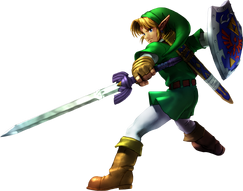
Link is featured as a guest star in SoulCalibur II, exclusively for the Nintendo GameCube version. Unlike the Super Smash Bros. series, this is the first and so far only time the character is included in a true fighting game, as well as a non-Nintendo title. His moveset in the game is known to be more brutal than what is seen in a typical 3D The Legend of Zelda game and even Smash Bros.. The incarnation of Link is the one from Ocarina of Time, like the first two installments of the aforementioned series.
Attention Mario Wiki users!: This section is short or lacks sufficient information. We would appreciate it if you help the Mario Wiki by expanding it.
In other media
Play Nintendo
Aside from being one of the main features in several Nintendo activities and being featured under the "Friends" section of the site, Link has appeared in some of the same Play Nintendo activities and videos as Mario, particularly those focused on Nintendo characters in general, such as Nintendo Trivia Quiz, in which Link is shown in the first question focused on The Legend of Zelda: Ocarina of Time 3D.
Attention Mario Wiki users!: This section is short or lacks sufficient information. We would appreciate it if you help the Mario Wiki by expanding it.
Timeline
[Edit] Game
|
Role | Year | Console | Notes |
|---|---|---|---|---|
| Tetris | Cameo | 1989 | Nintendo Entertainment System | When completing type B, Link is seen amongst a few Mario characters, Pit, and Samus in the results screen |
| F-1 Race | Cameo | 1990 | Game Boy | Link is briefly seen cheering on the player when completing course 4. |
| Super Mario Bros. & Friends: When I Grow Up | Cameo | 1992 | MS-DOS | Featured on the Chef/Waitress and Travel Guide pages |
| Donkey Kong Country 2: Diddy's Kong Quest | Cameo | 1995 | Super Nintendo Entertainment System | Shown as one of the characters at Cranky Kong's Video Game Heroes |
| Super Mario RPG: Legend of the Seven Stars | Cameo | 1996 | Super Nintendo Entertainment System | Found sleeping at the Rose Town inn |
| Donkey Kong Land 2 | Cameo | 1996 | Game Boy | Shown as one of the Video Game Heroes |
| Donkey Kong Country 3: Dixie Kong's Double Trouble! | Mentioned | 1996 | Super Nintendo Entertainment System | Mentioned by Bazaar if Dixie and Kiddy do not wish to hear his story about the Mirror |
| Super Smash Bros. | Playable character | 1999 | Nintendo 64 | |
| Mario Golf | Mentioned | 1999 | Nintendo 64 | Name mentioned on the score chart |
| Mario Golf | Mentioned | 1999 | Game Boy Color | Name mentioned on the score chart |
| Mario Artist: Paint Studio | Cameo | 1999 | Nintendo 64DD | There are a few stamps of Link depicting artwork of him from The Legend of Zelda: Ocarina of Time |
| Super Smash Bros. Melee | Playable character | 2001 | Nintendo GameCube | |
| Game & Watch Gallery 4 | Playable character | 2002 | Game Boy Advance | Playable in the port of the Zelda Game & Watch game |
| WarioWare, Inc.: Mega Microgame$! | Brief role | 2003 | Game Boy Advance | Playable in the microgame The Legend of Zelda |
| WarioWare, Inc.: Mega Party Game$! | Brief role | 2003 | Nintendo GameCube | Same as in WarioWare, Inc.: Mega Microgame$! |
| Donkey Konga 2 | Cameo | 2004 | Nintendo GameCube | Featured in a badge and as a slot machine panel |
| WarioWare: Twisted! | Brief role | 2004 | Game Boy Advance | Playable in the microgame The Legend of Zelda |
| WarioWare: Touched! | Brief role | 2004 | Nintendo DS | Appears in the ending of the microgame The Legend of Zelda |
| Donkey Konga 3 JP | Cameo | 2005 | Nintendo GameCube | Same as in Donkey Konga 2 |
| Tetris DS | Cameo | 2006 | Nintendo DS | Makes various cameos throughout, such as being one of the large sprites to appear on the Touch Screen in Missions mode |
| WarioWare: Smooth Moves | Brief role | 2006 | Wii | Playable in the Ocarina of Time and The Wind Waker microgames |
| Super Smash Bros. Brawl | Playable character | 2008 | Wii | |
| Captain Rainbow | Cameo | 2008 | Wii | A portrait of Link appears above Tracy's throne |
| Art Style: PiCTOBiTS | Cameo | 2009 | DSiWare | A few of the levels involves assembling a The Legend of Zelda sprite with Link in it. |
| WarioWare: D.I.Y. | Brief role | 2009 | Nintendo DS | Playable in the Zelda microgame |
| WarioWare: D.I.Y. Showcase | Brief role | 2009 | Wii (WiiWare) | Playable in the Zelda 2 microgame |
| Super Mario 3D World | Cameo | 2013 | Wii U | In a secret area of Rainbow Run, walking every tile gradually reveals an upscaled 8-bit sprite of Link. |
| Super Smash Bros. for Nintendo 3DS | Playable character | 2014 | Nintendo 3DS | |
| Mario Kart 8 (The Legend of Zelda x Mario Kart 8) | Playable character | 2014 | Wii U | |
| Super Smash Bros. for Wii U | Playable character | 2014 | Wii U | |
| Super Mario Maker | Playable character | 2015 | Wii U | Featured as one of the Mystery Mushroom outfits, with there also being one of Toon Link, Wolf Link, and Totem Link |
| Mario Kart 8 Deluxe | Playable character | 2017 | Nintendo Switch | Same as in Mario Kart 8, although the July 19, 2018 update relegates him as an alternate character of the Link from The Legend of Zelda: Breath of the Wild |
| WarioWare Gold | Brief role | 2018 | Nintendo 3DS | Returns as a playable character in the The Legend of Zelda, Ocarina of Time, and The Wind Waker microgames, and now also playable in the newly-added Phantom Hourglass microgame |
| Super Mario Maker 2 (version 2.0) | Playable character | 2019 | Nintendo Switch | Mario can transform into Link by touching the Master Sword power-up. |
| Super Mario 3D World + Bowser's Fury | Cameo | 2021 | Nintendo Switch | Same as in Super Mario 3D World |
| WarioWare: Get It Together! | Cameo | 2021 | Nintendo Switch | Shown to the right with the The Legend of Zelda: Breath of the Wild microgame |
| WarioWare: Move It! | Brief role | 2023 | Nintendo Switch | Appears in the The Legend of Zelda: Ocarina of Time 3D microgame |
| Super Mario RPG | Cameo | 2023 | Nintendo Switch | Same as in the original Super Mario RPG: Legend of the Seven Stars |
Trivia
- Being the mascot of the very successful The Legend of Zelda series and one of the first protagonists in video game history, Link has been widely described by critics and fans alike as one of the greatest or most influential video game characters of all time in a similar level to Mario from the Mario franchise. He is also considered the most critically acclaimed video game playable character and most ubiquitous action-adventure character according to Guinness World Records. Although never outright stated by Nintendo, some sources have even claimed Link as its secondary overall mascot behind Mario himself.
- As Link made his first appearance in 1986, he is one of Nintendo's oldest known characters not from Mario.
- Despite their completely different settings, due to The Legend of Zelda and Mario franchises have many parallels between each other, Link can be considered a mirror to Mario in that both main protagonists have the role in the majority of their core games of protecting a kingdom (Hyrule/Mushroom Kingdom, respectively) from a hideous recurring antagonist whose longtime primary goal is to take over that kingdom (Ganon/Bowser, respectively) and rescue a love interest princess (Zelda/Peach, respectively). Some Zelda titles, most prominently Link's Awakening and Tri Force Heroes, even have elements from the latter Nintendo series being encountered by Link, such as various Super Mario series enemies like Chain Chomps, Fire Bars, the Hammerwear, Fire Gloves, and so forth.
- According to Shigeru Miyamoto, the reason why the character is named "Link" comes from during the development of the original The Legend of Zelda, as the Triforce's fragments were originally planned to be electronic chips, he was the link between the past and the future, which was the original setting for the NES game (Ocarina of Time in the N64 appears to partially reuse this scrapped concept). Miyamoto has also stated that Link is named after the fact that he connects people together.
- According to the series' current director Eiji Aonuma, Link is named after the fact that he links the player to the games, as suggested by the character's name can be chosen by the player to match their own in most core installments.
- Coincidentally, Link's name is also a reference to the character being a link to himself, due to every incarnation throughout the franchise possessing the spirit of his original being, Hylia's Chosen Hero, from Skyward Sword.
- Link and Captain Falcon have shared the same weight value throughout the Super Smash Bros. series.
- In The Legend of Zelda: Link's Awakening, aside from various Super Mario enemies, in the Eagle's Tower dungeon, Link can encounter an enemy in what appears to be Kirby. However, unlike the real character, it is not quite as powerful and is actually called Anti-Kirby.
- Ironically, Kirby's Sword copy ability in his franchise is based on Link.
- Much of Link's Super Smash Bros. moveset as well as prior Zelda games was used for his appearance as a guest playable fighter in the 2002 Namco fighting game SoulCalibur II (GameCube version only). Many attacks even shared the same name as the names provided for Link's standard moveset on the Super Smash Bros. website.
- Similar to his appearance in SoulCalibur II, Mario, and sometimes Luigi and Princess Peach, have been featured in non-Nintendo media as guests themselves. Famous examples include the Electronic Arts titles SSX on Tour and NBA Street V3. Coincidentally, those games were released on the GameCube, and, for obvious reasons, must only appear in a Nintendo console in any case.
- Link and several other Nintendo stars would have made an appearance in the Starbeans Cafe in Mario & Luigi: Superstar Saga. However, they were all scrapped in favor of only Professor E. Gadd.
- In The Super Mario Bros. Movie, a road in Queens named "Link Street" is shown on the map in the Super Mario Bros. Plumbing commercial.
Gallery

|
To view Link's image gallery, click here.
|








